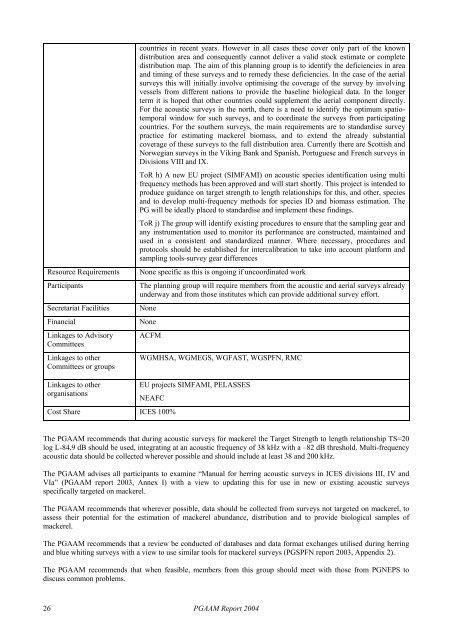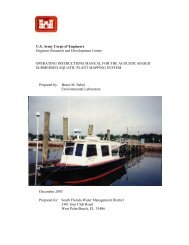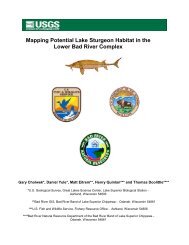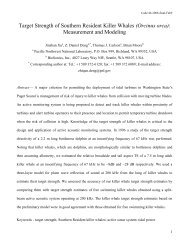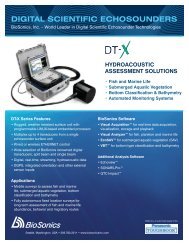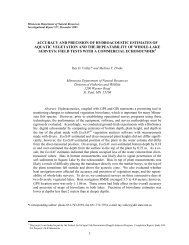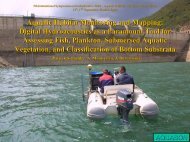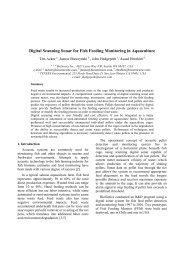Aerial and Acoustic Surveys for Mackerel - BioSonics, Inc
Aerial and Acoustic Surveys for Mackerel - BioSonics, Inc
Aerial and Acoustic Surveys for Mackerel - BioSonics, Inc
You also want an ePaper? Increase the reach of your titles
YUMPU automatically turns print PDFs into web optimized ePapers that Google loves.
Resource Requirements<br />
Participants<br />
Secretariat Facilities<br />
Financial<br />
Linkages to Advisory<br />
Committees<br />
Linkages to other<br />
Committees or groups<br />
countries in recent years. However in all cases these cover only part of the known<br />
distribution area <strong>and</strong> consequently cannot deliver a valid stock estimate or complete<br />
distribution map. The aim of this planning group is to identify the deficiencies in area<br />
<strong>and</strong> timing of these surveys <strong>and</strong> to remedy these deficiencies. In the case of the aerial<br />
surveys this will initially involve optimising the coverage of the survey by involving<br />
vessels from different nations to provide the baseline biological data. In the longer<br />
term it is hoped that other countries could supplement the aerial component directly.<br />
For the acoustic surveys in the north, there is a need to identify the optimum spatiotemporal<br />
window <strong>for</strong> such surveys, <strong>and</strong> to coordinate the surveys from participating<br />
countries. For the southern surveys, the main requirements are to st<strong>and</strong>ardise survey<br />
practice <strong>for</strong> estimating mackerel biomass, <strong>and</strong> to extend the already substantial<br />
coverage of these surveys to the full distribution area. Currently there are Scottish <strong>and</strong><br />
Norwegian surveys in the Viking Bank <strong>and</strong> Spanish, Portuguese <strong>and</strong> French surveys in<br />
Divisions VIII <strong>and</strong> IX.<br />
ToR h) A new EU project (SIMFAMI) on acoustic species identification using multi<br />
frequency methods has been approved <strong>and</strong> will start shortly. This project is intended to<br />
produce guidance on target strength to length relationships <strong>for</strong> this, <strong>and</strong> other, species<br />
<strong>and</strong> to develop multi-frequency methods <strong>for</strong> species ID <strong>and</strong> biomass estimation. The<br />
PG will be ideally placed to st<strong>and</strong>ardise <strong>and</strong> implement these findings.<br />
ToR j) The group will identify existing procedures to ensure that the sampling gear <strong>and</strong><br />
any instrumentation used to monitor its per<strong>for</strong>mance are constructed, maintained <strong>and</strong><br />
used in a consistent <strong>and</strong> st<strong>and</strong>ardized manner. Where necessary, procedures <strong>and</strong><br />
protocols should be established <strong>for</strong> intercalibration to take into account plat<strong>for</strong>m <strong>and</strong><br />
sampling tools-survey gear differences<br />
None specific as this is ongoing if uncoordinated work<br />
The planning group will require members from the acoustic <strong>and</strong> aerial surveys already<br />
underway <strong>and</strong> from those institutes which can provide additional survey ef<strong>for</strong>t.<br />
None<br />
None<br />
ACFM<br />
WGMHSA, WGMEGS, WGFAST, WGSPFN, RMC<br />
Linkages to other<br />
organisations<br />
EU projects SIMFAMI, PELASSES<br />
NEAFC<br />
Cost Share ICES 100%<br />
The PGAAM recommends that during acoustic surveys <strong>for</strong> mackerel the Target Strength to length relationship TS=20<br />
log L-84.9 dB should be used, integrating at an acoustic frequency of 38 kHz with a –82 dB threshold. Multi-frequency<br />
acoustic data should be collected wherever possible <strong>and</strong> should include at least 38 <strong>and</strong> 200 kHz.<br />
The PGAAM advises all participants to examine “Manual <strong>for</strong> herring acoustic surveys in ICES divisions III, IV <strong>and</strong><br />
VIa” (PGAAM report 2003, Annex I) with a view to updating this <strong>for</strong> use in new or existing acoustic surveys<br />
specifically targeted on mackerel.<br />
The PGAAM recommends that wherever possible, data should be collected from surveys not targeted on mackerel, to<br />
assess their potential <strong>for</strong> the estimation of mackerel abundance, distribution <strong>and</strong> to provide biological samples of<br />
mackerel.<br />
The PGAAM recommends that a review be conducted of databases <strong>and</strong> data <strong>for</strong>mat exchanges utilised during herring<br />
<strong>and</strong> blue whiting surveys with a view to use similar tools <strong>for</strong> mackerel surveys (PGSPFN report 2003, Appendix 2).<br />
The PGAAM recommends that when feasible, members from this group should meet with those from PGNEPS to<br />
discuss common problems.<br />
26<br />
PGAAM Report 2004


